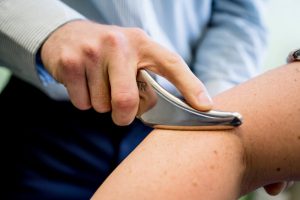What is Tennis Elbow?
Tennis elbow (aka lateral epicondylitis) is a painful condition that affects the muscles and tendons of the forearm where they attach to the outside of the elbow. It is typically from overuse of the muscles used to extend the wrist and fingers rather than from a single traumatic incident. If the extensor muscles in the arm aren’t strong enough, repetitive motions at work (that’s right, not just from tennis!) or during sport can cause the muscles/tendons to become inflamed and cause pain.
This pain can become severe enough to the point it can make working with our hands unbearable. The major goals in treating tennis elbow should be: 1) reducing pain/inflammation, 2) maintaining ROM, 3) increasing the strength and tolerance of the muscles so that the pain doesn’t return.
There are several treatment options to tackle tennis elbow, although not all of them are created equally. Unfortunately, some of the more common treatments fall into a “wait and see” treatment or offer pain relief with the risk of side effects.
Resting the elbow and/or the use of a brace are commonly prescribed treatments for reducing the pain associated with tennis elbow. While these can be effective at reducing symptoms, they both fail to strengthen the muscles and tendons to prevent the problem from reoccurring.
Pharmaceutical treatment options can include taking NSAIDs or corticosteroid injections to reduce the inflammation around the elbow. However, chronic NSAID use can lead to host of problems (increased cardiovascular risk, stomach ulcers, kidney problems) meaning they should only be during the initial stage of pain. Corticosteroid injections are often used for severe cases, although repetitive treatments have also been associated with tissue changes and muscle wasting too.
The Three Treatments You Need to Try
- Rehabilitation Exercises: By far one of the most important treatments that I find many patients are too lazy or possibly scared to try. If the condition is extremely painful, you’ll need a professional that will safely guide you through appropriate exercises that won’t flare up your problem. They may add in other therapies like ice, heat, ultrasound, or laser to help calm down the inflammation before pushing you too much on the exercise. Strategically strengthening the affected muscles in tennis elbow is one of the best ways to resolve the pain and prevent it from occurring again.

- Instrument Assisted Soft Tissue Mobilization (IASTM): Techniques such as FAKTR or Graston utilize handheld instruments to dig in and “scrape” over the affected tissues. When used correctly, IASTM can boost the healing process through increasing blood flow, stimulating the nervous system, recruiting cells to the area that help remodel the muscle tissue. Patients will often have an increase in their pain-free range of motion following these treatments.

- Low Level Laser Therapy: Sometimes called “cold laser therapy,” this treatment is making waves as a powerful new treatment to quickly reduce inflammation in an area. It’s effects are two fold. The laser quickly reduces the pain through improving blood flow while also rapidly decreasing some of the painful inflammatory markers found in our blood near injuries. The laser also speeds up healing times through a process called photobiomodulation, where the laser’s photons energize the cells allowing them to work harder and faster in the recovery process.







